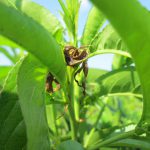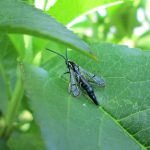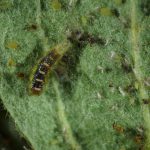After the critically cold temperatures in early April followed by several other nights of below freezing temperatures, NJ peach and apple growers have experienced loss of blossoms and/or fruit set. While the extent of the injury may still be too early to tell for some varieties, the cold weather has not stopped insect pests and where no fruit will be harvested we need to adjust our approach to insect management. This provides an opportunity to use selective materials where possible and allow natural enemy populations to attack some key pests.

Terminal flagging from Oriental fruit moth egg laying
Oriental Fruit Moth lays its eggs of at least the first and second generation in peach terminals. Due to low or absent fruit loads, the trees will be very flush and provide lots of oviposition sites. Injury to terminals is noticeable by “flagging” of the terminals. If unmanaged, populations will be high in 2017 and could be difficult to control. Thus management of at least the first and second generation OFM needs to occur. I would strongly recommend using mating disruption, such as OFM TT, for unharvestable orchards. This will control all 4 generations and significantly reduce OFM pressure next year without harming beneficial insects. Mating disruption dispensers are placed in the middle of the tree canopy and can be placed now. See label for rate information. Sprayable mating disruption such as Checkmate OFM-F can be applied at 1.32 – 2.93 oz/A applied just prior to adult flight and again during flight. For chemical options, we generally use 5-6 male moths in a trap as a trigger for management. If monitoring traps exceed 5-6, then the use of either Madex HP or a diamide chemistry (ie. Altacor) is recommended. Madex HP is an insect virus that only attacks OFM and codling moth and is very effective in both research and commercial trials in NJ at rates from 1.5 – 3.0 oz/acre. Both Madex and the diamides will have minimal impact on natural enemies but have good control of OFM and should be applied at diamide timing according to the DD model (see NJ Tree Fruit Production Guide or PPA posts from IPM scouting). Codling moth and OFM in apple will likely not require management but should still be monitored.

Peach tree borer
Borers such as dogwood borer, lesser and greater peach tree borer, are indirect pests of tree fruit and attack the tree trunk or branches. They will need to be controlled regardless of the fruit load if monitoring traps or other monitoring indicates an active population. We have two primary means of controlling borers. The first is mating disruption (ie. PTB Dual) and dispensers are placed around chest height in the canopy (closer to the bottom of the canopy). Dispensers should be placed in early – mid May. This will disrupt mating of female moths within the orchard. The second option is chemical treatment with Lorsban as a trunk application. Lorsban is currently under review by the EPA and is at risk of being pulled from use after this growing season. A combination of Lorsban and mating disruption is a very effective tactic for treating established injury and preventing new injury and should be considered this year.
White peach scale and San Jose scale have been problematic in many orchards in recent years. This is likely due to increases in pyrethroid use for brown marmorated stink bug control. Many growers applied dormant oil pre-bloom to control scale. Evaluations are showing varying levels of effectiveness this year for unknown reasons. Despite this, I would not recommend further treatment for scale. In an orchard under good IPM practices, scales can be controlled naturally by a combination of parasitoid wasps and predatory beetles. Under low fruit conditions where the orchard will not be sprayed, this will allow natural enemy populations to recover and time to rebound their populations and feed on scale.
Plum curculio lays eggs in developing fruit. If there are no fruit in the block then management is not required. If the block experienced low population pressure in 2015 you may decide management is not needed. However, if the block has a history of high PC injury one well timed management application will keep pressure lower for next year. PC is active now in South Jersey and is starting to become active in Northern orchards. Normal timings for management would be shuck-split in peaches or petal fall in apples or at first cover.

Syrphid (Hover fly) larvae consuming apple aphids
The above recommendations are only for blocks that have experienced significant freeze injury and a harvest is not planned. Remaining fruit in the orchard will likely have insect injury. The critical thing to remember is that we need to prevent specific insect pests from either increasing in population pressure for next year or injuring the tree. However, minimal management of the orchard allows us the opportunity to let the natural enemy populations such as lady beetles, parasitoid wasps, lacewings, syrphid larvae, to build their populations and have a greater impact in future years. If a harvest is still expected, even under low fruit conditions, plum curculio and OFM need to be managed as well as monitoring for stink bug and other key pests as usual.

